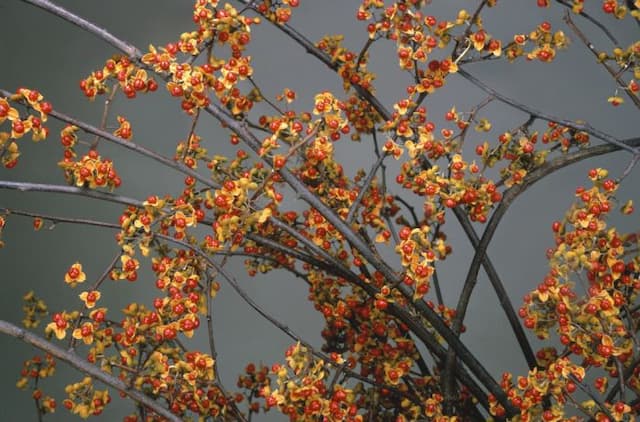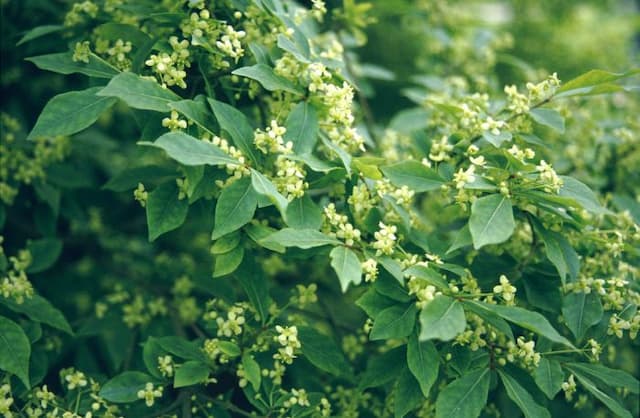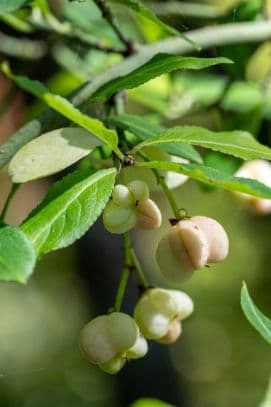Winged spindle Euonymus alatus

ABOUT
The Euonymus alatus is an evergreen shrub that can reach a height of 8 to 12 feet (96 to 144 inches) and a spread of 7 to 10 feet (84 to 120 inches). Its bark is a decorative reddish-brown color with 3-4 strips that go down the main stem. It has small, rounded, dark-green leaves with a silvery-white edge. Its leaves should be pruned annually to maintain shape and encourage growth. The Euonymus alatus is most recognized for its bright red berries in the fall season and its upright spreading branches that resemble wings, giving it the nickname "the Burning Bush".
About this plant
 Names
NamesFamily
Euonymaceae
Benefits
 General Benefits
General Benefitsof each benefit. 1. Cold Tolerance: Euonymus alatus plants are especially hardy in cold weather, making them an ideal choice for gardeners in cooler climates. 2. Low Maintenance: This shrub requires little pruning, and is drought tolerant, so it can be grown in some of the poorest soils without the need for extra watering or fertilizers. 3. Attracts Birds and Butterflies: Euonymus alatus plants produce small red berries that attract hungry birds as well as butterflies and other beneficial insects. 4. Colorful: This versatile shrub can be trained to form a small tree and its foliage turns a brilliant red in the fall, making it stand out in any landscape design. 5. Fast Growing: Euonymus alatus grows rather quickly, allowing gardeners to enjoy the beautiful foliage and flowers in a very short period of time. 6. Deer Resistant: Deer are not attracted to this shrub and will often avoid it, making it an excellent choice for problem deer areas.
 Medical Properties
Medical Properties. 1. Sulphur substances: a compound of sulfur and oxygen believed to aid detoxification and stimulate digestion. 2. Vitamin C: known to boost immunity and support collagen production. 3. Anti-inflammatory: has anti-inflammatory properties, especially when it comes to the digestive system. 4. Laxative: contains powerful laxative properties, helping to treat constipation. 5. Astringent Properties: can be used topically to tone and tighten skin, as well as contract muscle tissue. 6. Anti-microbial Properties: can be used to treat common skin infections, such as dermatitis, eczema, and acne. 7. Cardio Tonics: believed to help with cardiovascular health, decreasing cholesterol and plaque build up. 8. Diuretic Properties: helps to encourage urine flow and eliminate excess water from the body. 9. Antioxidant Properties: helps to protect the body from free radical damage. 10. Immune Booster: assists with strengthening the body’s natural defense responses.
 Air-purifying Qualities
Air-purifying QualitiesEuonymus alatus is an evergreen plant with air purifying qualities that can help reduce air pollution, including pollutants such as benzene, formaldehyde, and xylene. The plant's leaves, when crushed, also release a pleasant scent, making it ideal for a home or office space. Additionally, the plant can improve indoor air quality by trapping dust and absorbing gases like carbon dioxide and releasing oxygen. Therefore, it is an excellent choice for a natural air purifier.
 Other Uses
Other Uses. 1. Mulching - The branches and twigs of Euonymus alatus are often used as mulching material due to their beneficial properties for the plants´ rooting environment. 2. Wreath Basket - The dried branches from the Euonymus alatus can be used to make wreaths, door hangers and decorative baskets in the home. 3. Composting - The leaves and twigs of Euonymus alatus are often used in compost piles to increase healthier soil composition. 4. Natural Pesticide - The leaves and branches of the Euonymus alatus can be used as a natural pesticide for gardens and plants providing an ecofriendly way to control pests. 5. Dyeing Fabric - The leaves and twigs from the Euonymus alatus can be used as a form of natural dyeing for fabric, natural fibers and even paper. 6. Furniture Stain - The branches and berries of the Euonymus alatus can be boiled and made into a natural wood stain giving furniture a unique multi-coloured hue. 7. Garden Edging - The Euonymus alatus can be used as an edging for gardens due to its low-maintenance nature and dense thicket.
Interesting Facts
 Feng Shui
Feng ShuiEuonymus alatus (also known as Burning Bush) can be used according to Feng Shui to bring energy, good luck and blessings into your home. It is best to place this plant in an east or southeast corner of your home, as these sectors are associated with family, health and abundance energy. Placing the plant in an office or workspace will bring an energy boost that can increase productivity and improve luck. Additionally, you can use a small pot of this plant to guard against negative energies near the entrance of your home.
 Zodiac Sign Compitability
Zodiac Sign Compitability. The Euonymus alatus, also known as the Winged Euonymus, is best associated with the sign of Aquarius, the Water Bearer. This is due to the combination of the plant's characteristics, which include its ability to withstand harsh climates, its long-term endurance, and its vibrant, brilliant shades of red and orange. All of these elements align with the independent and rebellious spirit of the Aquarius and their ability to remain strong and creative despite external influences.
 Plant Symbolism
Plant SymbolismEuonymus alatus, commonly known as the burning bush, is a deciduous shrub native to East Asia. It has a dense, multi-stemmed growth habit, and its leaves turn bright red in fall. It is often used as an ornamental shrub in gardens and parks, as it provides a memorable show of fall color. In Christian symbolism, the burning bush is a representation of the miracle of Moses from the Bible, whereby God speaks to him from a bush that miraculously does not burn down. This is seen as a metaphor for the experience of spiritual awakening and divine guidance, and for the importance of the moment when spiritual truth is revealed to one. The leaves of the shrub represent the divine guidance and grace that was revealed to Moses, while the leaves turning red in the fall represents renewal and transformation. The shrub as a whole is a symbol of spiritual awakening, perseverance, and transformation.
 Water
WaterEuonymus alatus should be watered on an as-needed basis. This can usually be determined by checking the soil, as the Plant should only be watered when the upper 2 inches of soil is dry. When watering, it is important to make sure that the soil is thoroughly saturated, as the Plant does not like sitting in damp or soggy soil. The watering should be done slowly and steadily in order to allow the water to penetrate the soil. Euonymus alatus does not need a significant amount of water, as it is a fairly resilient Plant, but it should be given enough water so that the roots are hydrated and the soil is moist.
 Light
Light. Euonymus alatus prefers bright indirect light, meaning a spot that is exposed to natural sunlight but not directly in the full sun. The best spot for this plant would be near an east- or west-facing window that receives several hours of natural light each day.
 Temperature
TemperatureThe best lighting conditions for Euonymus alatus are full sun to part shade. The best summer temperature for this plant is between 65 and 75 degrees Fahrenheit, while the best winter temperature is between 20 and 45 degrees Fahrenheit.
 Pruning
PruningEuonymus alatus, commonly known as Burning Bush, should be pruned twice per year. The first pruning should be done in the spring shortly after new growth has started. During this pruning, broken, dead or diseased branches can be removed. The second pruning should be done in the summer, between mid-July and early August. This pruning, known as thinning, should be done to reduce the overall size of the shrub and promote better air circulation and light penetration. To accomplish this, one should remove no more than a third of the branches and typically select the oldest and tallest branches, but avoid removing all the branches from just one side of the shrub.
 Soil
Soiland do not use images. To create the best soil mix for Euonymus alatus, start with a base of 4 parts of a mixture of 1 part compost, 1 part perlite and 2 parts peat moss. For Euonymus alatus, aim for a soil pH of 5.5 to 6.5. Incorporate a slow-release fertilizer throughout the soil before planting, adding 1/4 cup per 4 square feet of planting bed. Lastly, add 1 to 2 inches of mulch on top of the soil to help retain moisture.
 Repotting
Repottingsomething Yes, it is recommended to repot Euonymus alatus every 2-3 years.
 Humidity & Misting
Humidity & MistingThe best humidity conditions for Euonymus alatus is a relative humidity between 40%-60%. To increase the humidity, mist the plant on a regular basis or place it in a room with a humidifier. To decrease the humidity, take the plant to a room with a lower relative humidity or decrease the amount of misting.
 Suitable locations
Suitable locationsIndoor
Euonymus alatus grows best indoors in a bright, sunny location away from drafts, with temperature ranging between 60-70°F. It prefers to be planted in well-draining, acidic soil and should be watered regularly. It should be kept in a pot between 6-8 inches deep and should be fertilized every 4-6 weeks. To encourage it to spread, prune off deadwood and pinch back young shoots.
Outdoor
Euonymus alatus grows best when in an area that has partial shade and receives full sun for at least four hours each day. It should be planted in well-drained soil and an area with moderate temperatures of 40-90°F. It is recommended that it should receive an inch of water per week throughout the growing season. It should be planted in an area that has a soil pH between 5.5 and 6.5. In addition, it is best for Euonymus alatus to be planted in a spot that has sufficient air circulation, with a minimum of six feet of space around the plant to allow light and air movement.
Hardiness zone
Hardiness Zones
 Life cycle
Life cycleEuonymus alatus, commonly known as burning bush, is a deciduous shrub native to East Asia. In the springtime, its newly emerging leaves turn bright red, and in the fall they turn a deep orange-red before falling off. The shrub grows up to 6-10 feet tall, with wild varieties reaching up to 15 feet in height. It grows best in full sun, but tolerates shade as well. It prefers moist, slightly acidic soil and can tolerate temperatures as low as 5°F. The shrub has shallow, fibrous roots and produces white, fragrant flowers in early summer. The flowers give way to small round fruits that start off green and mature to orange-red in autumn. These fruits split open to reveal bright scarlet-orange seeds, which are dispersed by birds. Burning bushes are highly resistant to pests and diseases and require little maintenance.
 Propogation
PropogationPropagation of Euonymus alatus can be accomplished in two ways: seed and cutting. Seed: Euonymus alatus seeds should be collected in the fall when the berries are ripe and red. Remove the fleshy berries, and lightly cold stratify the seeds in the refrigerator by spreading them on a moist paper towel and storing in a sealed plastic bag or jar. Plant outside in early spring when the soil and air temperatures reach at least 45°F. Cuttings: Take cuttings from Euonymus alatus in the late summer or early autumn. Cuttings should be 3-4 inches long and taken from the current season's growth. Remove the lower leaves and place the cuttings in a moist potting mix and a plastic bag to maintain humidity. Place in a bright, indirect light location. When a good root system is established, transplant outdoors to a prepared bed about 6-7 feet apart.




![Spindle [Blondy]](/_next/image?url=https%3A%2F%2Fplants-admin.emdemapps.com%2Fimages%2Fplants%2F%2Fimages%2F604b642f54add.png&w=640&q=75)



